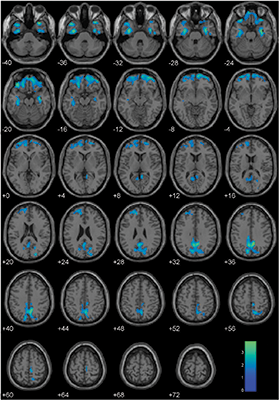Elsa Ermer, Ph.D. uses an fMRI scanner to analyze psychopaths’ brain activity in a quest to understand how best to treat psychopathy.

Brain scans reveal that people with higher psychopathy scores have less gray matter (brain tissue that correlates with abilities and intelligence) in the regions colored blue. The color bar shows the scale of the effect. Areas that are more green are the regions where psychopaths showed greater differences from controls.
Picture this. You’re in Nazi Germany hiding with your baby and the members of your town. Your baby starts crying. If your baby keeps crying, the Nazis are going to kill everyone. What is the moral choice?
If you’re struggling with the answer, you’re not alone, says Elsa Ermer, Ph.D., an assistant professor at the Gordon F. Derner Institute of Advanced Psychological Studies. In her research into social cognition, Dr. Ermer has found that most people are slow to respond to this question and similar ones that test moral reasoning. Most of us have two decision-making systems—an emotional one that in this case tells us not to harm others and a rational one that tells us it’s better to save more lives. “People feel that conflict and then it takes them a while to decide what’s right,” Dr. Ermer says.
Dr. Ermer and Kent Kiehl, Ph.D., a professor at The University of New Mexico, have been asking incarcerated psychopaths how they would act in the Nazi scenario. Dr. Ermer and Dr. Kiehl bring a functional magnetic resonance imaging (fMRI) scanner to prisons to analyze psychopaths’ brain activity while they respond. In general, psychopaths choose to sacrifice the baby to save the town, and they decide much more quickly. Their “emotional system is either damaged, not working or just working at a lower level so it’s that rational calculus that’s taking over,” Dr. Ermer says.
Prior fMRI research on psychopaths has revealed that they have less tissue in their paralimbic cortex—part of the brain where emotions are processed. People with psychopathy also show reduced activity in these areas when making moral decisions.
The moral reasoning experiments are part of a series of studies that Dr. Ermer and Dr. Kiehl are undertaking with the ultimate goal of understanding how best to treat psychopathy. While psychopaths constitute just 1 percent of the general population, they represent 15 to 20 percent of the prison population.
For further information, please contact:
Todd Wilson
Strategic Communications Director
p – 516.237.8634
e – twilson@adelphi.edu